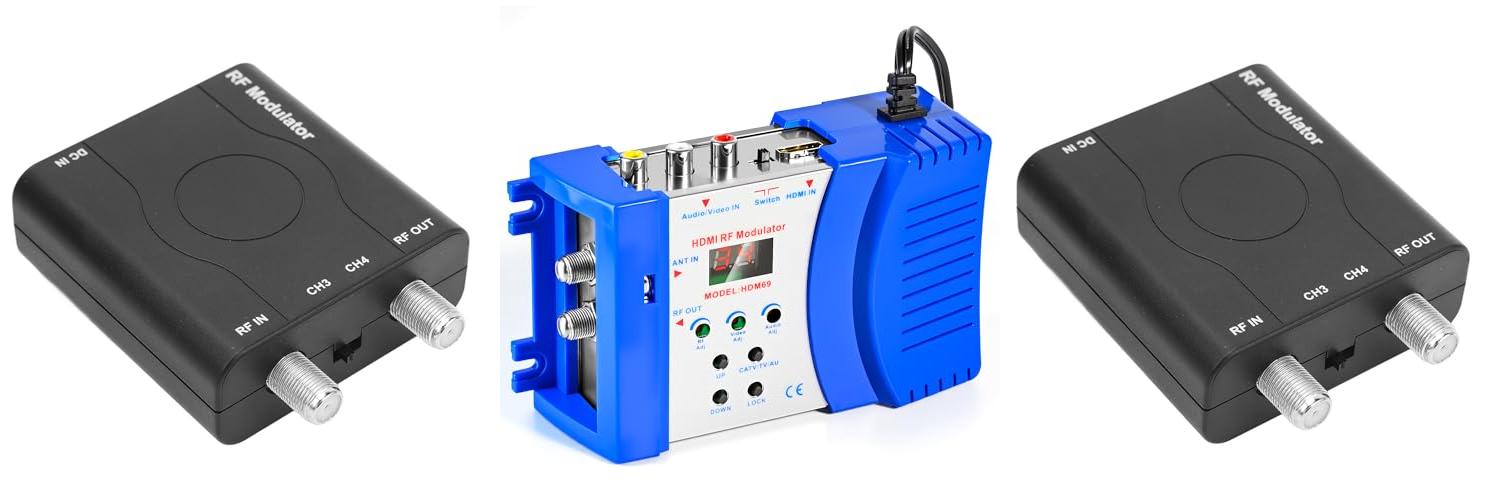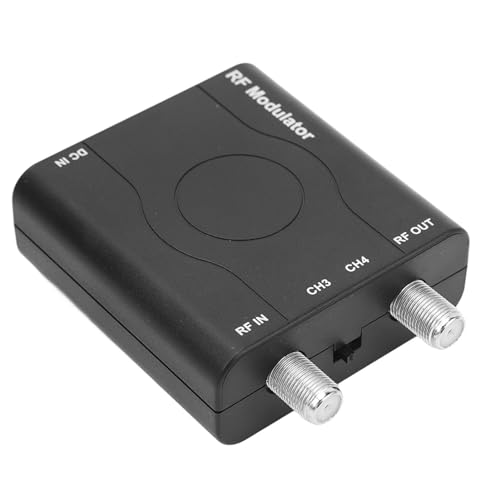Ever wanted to share your awesome video games or cool movies on every TV in your house, not just the one near your console? It sounds like a dream, right? Well, it’s totally possible with a special gadget called an HDMI RF modulator. But figuring out which one to buy can feel like trying to solve a puzzle with missing pieces. There are so many choices out there, and it’s tough to know which one will actually work the best for you.
Choosing the wrong one can lead to fuzzy pictures, weird sounds, or it just not working at all. That’s frustrating! You just want to enjoy your entertainment without the hassle. That’s why we’re here to help. By the time you finish reading this, you’ll understand what an HDMI RF modulator does and how to pick the perfect one for your needs. No more confusion, just clear pictures and happy viewing!
So, let’s dive in and explore the world of HDMI RF modulators. We’ll break down what makes a good one and guide you through finding the best fit for your home entertainment setup. Get ready to boost your viewing experience!
Our Top 5 Hdmi Rf Midulator Recommendations at a Glance
Top 5 Hdmi Rf Midulator Detailed Reviews
1. HDMI RF Modulator Adapter
Rating: 8.6/10
This HDMI RF Modulator Adapter is a handy gadget that lets you send your HD video from an HDMI source to an older TV that only has an RF coaxial input. It’s designed to work with the NTSC format, which is common in many places. You can get a clear 1080P picture, and it’s made to be tough and last a long time.
What We Like:
- It supports the NTSC format, so it should work with many TVs.
- It can handle 1080P video, giving you a good picture quality.
- The PLL control helps keep the signal strong and steady on VHF frequencies.
- It’s super easy to set up – just plug it in, and it works without any software.
- The adapter is built with strong ABS material, meaning it’s built to last.
- It’s compatible with HDMI 1.4 and HDCP 1.4, which are important for modern video.
What Could Be Improved:
- It only supports NTSC format, so it won’t work if your TV system uses PAL.
- The specific VHF frequencies it uses (CH3 and CH4) might already be in use in some areas, potentially causing interference.
This adapter is a solid solution for connecting modern devices to older TVs. It offers good performance and is incredibly simple to use.
2. HDMI to RF Modulator
Rating: 9.0/10
This HDMI to RF Modulator, VHF UHF AV to RF Coaxial Converter, CVBS RCA HDMI to RF Modulator, for TV PAL NTSC Format, for Home TV Switch Audio Video, F Female Connectors is a handy gadget for connecting modern devices to older TVs. It lets you send signals from HDMI or older RCA (AV) sources to your TV’s coaxial cable input. This means you can watch your favorite shows from streaming devices, gaming consoles, or DVD players on almost any television.
What We Like:
- It handles both VHF and UHF frequencies, giving you more options.
- You can connect devices using HDMI or RCA cables.
- It supports many different screen resolutions, including 1080P, so your picture looks good.
- The output is direct via F Female connectors, which are common.
- No complicated software installation is needed; just plug it in.
- You can adjust the audio and video output level to match your TV.
- It’s small and light, making it easy to put anywhere.
- It’s built with strong ABS and metal, so it should last a long time.
What Could Be Improved:
- The description could be clearer about which specific PAL/NTSC formats are supported without needing further research.
- While compact, the included cables might be short for some setups.
This modulator is a versatile tool for bridging the gap between new and old entertainment systems. It offers good flexibility and durability for its price.
3. FOSA HDMI to RF Modulator
Rating: 9.4/10
The FOSA HDMI to RF Modulator (HDM61) is a handy device that lets you connect modern HDMI devices, like a Blu-ray player or gaming console, to older TVs that only have an RF coaxial input. It converts your HD signal into a format that your older TV can understand, making your old TV feel new again. It supports the NTSC format, common in North America, and works with high-definition resolutions up to 1080P.
What We Like:
- It supports NTSC format output, which is great for many TVs.
- The 1080P PLL control ensures a clear picture.
- It’s built with fine workmanship and supports HDMI 1.4 and HDCP 1.4.
- It’s plug and play, meaning you don’t need to install any software.
- The ABS material makes it rugged and long-lasting.
- It offers stable performance thanks to professional manufacturing.
What Could Be Improved:
- It only supports NTSC format output, so it might not work in regions that use other formats like PAL.
- The specific frequency ranges (CH3, CH4) might require some tuning on your TV.
This modulator is a simple solution for bridging the gap between your new HDMI devices and your older TV. It’s a reliable choice for enjoying your favorite content on a classic screen.
4. RF Demodulator Coax to HDMI UHF Modulator VHF Adapter Coaxial Converter for JVC Videodisc Betamax VCRs VHS Camcorder Video CD Player Magnavox Odyssey Atari 2600 to HDTV HD Digital Projector Monitor TV
Rating: 8.7/10
Unearth your retro gaming and video treasures with this incredible RF Demodulator Coax to HDMI adapter! This device bridges the gap between your beloved vintage electronics and your modern HDTVs. It’s your ticket to replaying classic games from systems like the Atari 2600, NES, and Sega Master System, or watching old Betamax tapes and VHS recordings on your big, beautiful HD screen. No more dusty, small screens for your old media!
What We Like:
- It lets you connect a huge variety of old game consoles and VCRs to your modern TV.
- It converts analog signals (VHF/UHF) to digital HDMI, so your old stuff looks better on new screens.
- It’s plug-and-play, meaning no complicated setup or extra software is needed.
- The included remote control adds convenience for features like timers and channel selection.
- It supports both NTSC and PAL TV formats, making it versatile for different regions.
- It can even receive up to 251 TV channels, acting like a digital tuner for older analog signals.
What Could Be Improved:
- The name of the product is very long and hard to say.
- It requires a wired TV signal cable to work for some functions.
- While it converts signals, the quality will still depend on the original analog source.
This adapter is a fantastic solution for anyone wanting to relive classic gaming memories or enjoy old video formats on today’s technology. It makes your old electronics compatible with your new displays, bringing your past into the present.
5. HDMI RF Modulator Coax Converter VHF Adapter w/Male F Type Cord for PS4 PS5 Xbox Nintendo Switch VCR DVD Player Roku Fire Stick Set-top Cable Box HD Digital Video Input to Coaxial Out Analog NTSC TV
Rating: 8.9/10
Is your new game console or streaming stick gathering dust because your old TV doesn’t have an HDMI port? This HDMI RF Modulator Coax Converter is your solution! It cleverly transforms modern HDMI digital signals into analog VHF signals. This means you can connect your PlayStation 5, Xbox Series X, Nintendo Switch, Roku, Fire Stick, or even your laptop to older CRT TVs or any device that uses coaxial cable input. Enjoy your favorite movies, games, and photos on a classic screen!
What We Like:
- Connects new HDMI devices to old TVs.
- Works with a wide range of devices like game consoles, streaming sticks, DVD players, and computers.
- Allows you to watch videos and play games on channel 3 of older TVs.
- Has a zoom function and remote control for adjusting screen settings like brightness and contrast.
- Supports ultra-long distance transmission of signals, letting you share content in different rooms.
What Could Be Improved:
- Image quality is lower than modern standards, similar to 480p, because it converts to analog.
- This converter only outputs specific TV formats (PAL-BG, PAL-l, PAL-DK, and NTSC-M). Your TV must support one of these to work.
- It does NOT work in reverse; it cannot convert RF signals back to HDMI.
- Not compatible with ATSC format TVs.
This adapter bridges the gap between new and old technology, making your vintage entertainment setup feel modern again. Just ensure your older TV supports one of the listed analog formats for a seamless connection.
Your Smartest Purchase: The HDMI RF Modulator Buying Guide
Thinking about a new HDMI RF modulator? This guide will help you pick the right one. We’ll cover what makes a good modulator and what you need to know before you buy.
What is an HDMI RF Modulator?
An HDMI RF modulator takes a video and audio signal from an HDMI port and turns it into a radio frequency (RF) signal. This RF signal travels through coaxial cables, like the ones for your TV antenna. It lets you send your HDMI source to TVs that don’t have HDMI inputs, or to multiple TVs over a long distance.
Key Features to Look For
1. Output Channel Selection
Look for modulators that let you choose the output RF channel. This is important. It helps you avoid interference from other signals in your home. Most modulators offer a range of VHF or UHF channels. Some have digital channel selection which is easier to use. A good range of channels gives you more flexibility.
2. Input/Output Resolution Support
Check what resolutions the modulator supports. Most modern HDMI sources output 1080p. Make sure your modulator can handle this. If it only supports 720p, your picture quality will be lower. Some modulators also support older resolutions like 480i or 480p. This is good if you have older TVs.
3. Audio Support
Ensure the modulator supports the audio format you need. Most HDMI sources use stereo audio. Some advanced modulators might support surround sound. For most users, stereo audio is perfectly fine. Make sure it has clear audio output.
4. Built-in Amplifier (Optional but Useful)
Some modulators have a built-in amplifier. This boosts the RF signal. It’s helpful if you need to send the signal a long distance or to many TVs. This feature helps maintain a clear picture and sound.
5. Durability and Build Quality
A well-built modulator lasts longer. Look for sturdy metal casings. Avoid plastic ones that feel cheap. Good connectors also indicate better quality.
Important Materials
Most HDMI RF modulators use electronic components like circuit boards, resistors, and capacitors. The casing is often made of metal, like aluminum, for durability and heat dissipation. Some might use plastic for parts of the casing. Ensure the connectors are gold-plated for better signal transfer.
Factors That Improve or Reduce Quality
Improving Quality:
- High-Quality Components: Better internal parts lead to a cleaner signal.
- Good Signal Processing: Advanced chipsets convert the HDMI signal more accurately.
- Proper Channel Selection: Choosing a clear RF channel reduces static and interference.
- Stable Power Supply: A reliable power adapter keeps the modulator working correctly.
Reducing Quality:
- Low-Quality Components: Cheap parts can create a noisy signal.
- Poor Conversion Process: Inefficient signal conversion leads to a fuzzy picture.
- Interference: Using a busy RF channel can cause a weak or distorted signal.
- Long, Unshielded Cables: Poor quality coaxial cables can degrade the signal.
User Experience and Use Cases
Ease of Use
A good modulator is easy to set up. You plug in your HDMI source. Then, you connect the coaxial cable to your TV or distribution system. Simple controls make channel selection and setup straightforward. A clear display helps you see the current settings.
Common Use Cases
- Connecting to Older TVs: If you have a smart TV with HDMI but want to send its signal to an older TV in another room without HDMI.
- Distributing a Signal to Multiple TVs: Use a modulator and a coaxial splitter to send one HDMI source to several TVs throughout a house or building.
- Security Systems: Some security camera systems use RF distribution. A modulator can integrate HDMI sources into these systems.
- Digital Signage: Displaying information or advertisements on multiple screens in a commercial space.
Frequently Asked Questions (FAQ)
Q: What is the main purpose of an HDMI RF modulator?
A: Its main purpose is to convert an HDMI signal into an RF signal. This lets you send video and audio to TVs that only have coaxial inputs or over long distances using coaxial cable.
Q: Do I need a special antenna for an HDMI RF modulator?
A: No, you use standard coaxial cable. The modulator itself creates the RF signal that your TV antenna input receives.
Q: Can I use any HDMI cable with a modulator?
A: Yes, you can use any standard HDMI cable. The quality of the HDMI cable won’t significantly impact the RF output quality.
Q: What is RF interference, and how do I avoid it?
A: RF interference is unwanted signals that can disrupt your picture. You avoid it by choosing an unused RF channel for your modulator. Check local TV channels to find clear ones.
Q: How many TVs can I connect to one modulator?
A: The number depends on the modulator’s power and if it has a built-in amplifier. You usually connect it to a coaxial splitter to send the signal to multiple TVs.
Q: Will the picture quality be the same as a direct HDMI connection?
A: No, there might be a slight reduction in picture quality compared to a direct HDMI connection. However, a good modulator will maintain a very watchable and clear picture.
Q: Are HDMI RF modulators difficult to set up?
A: Most are quite simple to set up. You connect your HDMI source, connect the coaxial cable, and select an output channel. The manual usually provides clear instructions.
Q: Can I convert an RF signal back to HDMI?
A: No, an HDMI RF modulator only works in one direction: HDMI to RF. You would need a different device, an RF to HDMI converter, for the opposite direction.
Q: What is the difference between a modulator and a splitter?
A: A splitter divides an existing signal to multiple outputs. A modulator changes the type of signal (HDMI to RF). You often use them together.
Q: Are there silent HDMI RF modulators?
A: Most modulators are silent in operation. Some might have a small fan for cooling, but this is usually very quiet.
In conclusion, every product has unique features and benefits. We hope this review helps you decide if it meets your needs. An informed choice ensures the best experience.
If you have any questions or feedback, please share them in the comments. Your input helps everyone. Thank you for reading.






